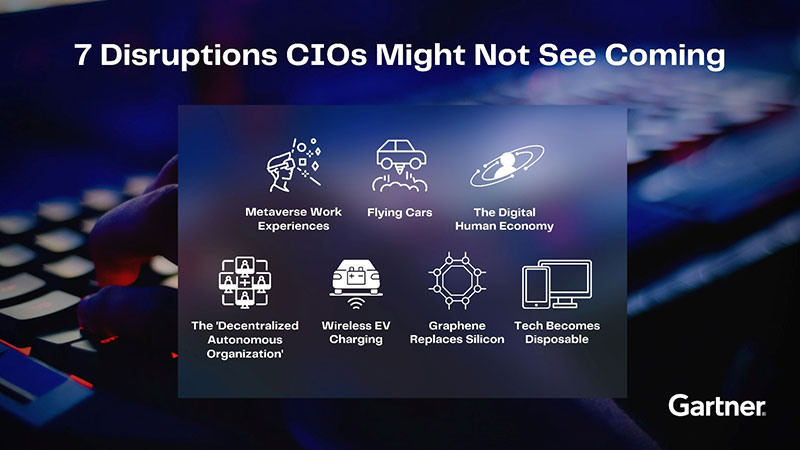Many disruptions that seem futuristic may be closer than we think.

By David Yockelson is a Research Vice President at Gartner
CIOs must take time to consider “what if” scenarios to avoid being blindsided by social, behavioral and technological disruptions
“Disruptions are fundamental shifts that create lasting change, and successful organizations will be those that are prepared to address them,” Yockelson said. “We need to keep asking “what if” to remain open to opportunities presented by disruptions.”
Seven key disruptions that technology executives should consider in the next five years.

- Metaverse Work Experiences
Today, organizations are harnessing metaverse technologies to provide better engagement, collaboration and connection to their employees through better immersive workspaces in virtual offices and the use of internal metaverse experiences called intraverses.
Gartner predicts that fully virtual workspaces will account for 30% of the investment growth in metaverse technologies and will reimagine the office experience through 2027.
- Flying cars
Flying autonomous vehicles, or unmanned aerial vehicles (UAVs), are for carrying passengers, primarily over short distances in urban areas. These encompass self-operating aircrafts that are sometimes referred to as “flying cars” or passenger drones and are designed to operate without a human pilot. Several companies are working on new aircraft piloted by artificial intelligence and designed to create a faster, less expensive, safer, and lower carbon way to execute air travel, primarily in congested areas. The first flying taxi service is scheduled to launch in 2024.
Notwithstanding potential regulatory challenges, CIOs should assess what problems in transportation — moving people and cargo — might be solved by using these vehicles.
- The Digital Human Economy
From medical care, customer service, virtual influencers and HR training to bringing the deceased “back to life”, the possible uses for digital humans are endless. A digital human economy provides the opportunity for a new digital ecosystem, underpinned by technology that brings individuals and organizations together to innovate and interact in new ways.
Gartner predicts that by 2035, the digital human economy will become a $125-billion market and continue to grow.
- The “Decentralized Autonomous Organization”
Decentralized autonomous organizations (DAOs) represent a new type of organization model emerging in the IT services marketplace. Gartner defines a DAO as a digital entity, running on a blockchain, which can engage in business interactions with other DAOs, digital and human agents, and corporations, without conventional human management.
Many high-value digital workers will be attracted to working in DAOs. Though in their infancy, DAOs have the potential to be highly disruptive to many current norms of the technology industry.
- Wireless Electric Vehicle (EV) Charging
As it becomes available, wireless charging will make the most sense for fleet vehicles such as buses and taxis. These vehicles can make effective use of dynamic charging to extend range and reduce costs.
Subsequently, residential installations will be the biggest market for wireless vehicle charging, as EV owners enjoy the modest convenience of not having to plug a cable in. However, looking out beyond that time, Gartner expects that private housing estates and campus sites will overtake in-home installations by volume.
- Graphene Replaces Silicon
During the next seven to 10 years, there is a huge potential for carbon-based field-effect transistors (FETs) to replace silicon in traditional transistors when they reach their minimum size limits. One example is graphene, a one-atom thick material of pure carbon, bonded together in a hexagonal honeycomb lattice. Graphene could displace current silicon devices, especially for wireless communications, where these carbon-based FETs can carry a much higher current in a small area, enabling super quick processing.
CIOs should consider new possibilities enabled by graphene-based technologies and start to identify emerging suppliers.
- Tech Becomes Disposable
What if the technology industry starts to mirror the fashion industry, with “throwaway” applications designed to be made, used and disposed of quickly? While elements of business composability are already widely practiced, there are opportunities for CIOs to take it to the next level and prepare for the flexibility of disposable technology.
Learn which technologies will drive digital business and innovation in 2022 in the Gartner Top Strategic Technology Trends for 2022 e-book.
มีหลายเหตุการณ์ที่เปลี่ยนโลกไปอย่างสิ้นเชิง และดูเหมือนว่าโลกอนาคตอาจอยู่ใกล้ตัวเรามากกว่าที่คิด

โดย เดวิด ยอคเคลสัน รองประธานฝ่ายวิจัย การ์ทเนอร์
ซีไอโอต้องใช้เวลาเพื่อพิจารณาถึงสถานการณ์ “จะเกิดอะไรขึ้นถ้า… (หรือ What If)” เพื่อไม่ให้เป็นการปิดหูปิดตาตัวเองจากกระแสดิสรัปชั่นทางสังคม พฤติกรรม และเทคโนโลยี ที่มีผลต่อการเติบโตขององค์กร
“การดิสรัปชั่นเป็นพื้นฐานของการเปลี่ยนแปลงที่ส่งผลต่อเนื่องอย่างถาวร และองค์กรที่ประสบความสำเร็จคือองค์กรที่พร้อมรับมือกับมัน โดยเราต้องตั้งคำถาม “จะเกิดอะไรขึ้นถ้า…” ต่อไปเรื่อย ๆ เพื่อเปิดรับโอกาสที่มาพร้อมกับการดิสรัปชั่น”
การเปลี่ยนแปลงครั้งใหญ่ 7 อย่างที่ผู้บริหารด้านเทคโนโลยีทั้งหลายควรใส่ใจพิจารณาในอีก 5 ปีข้างหน้านี้ ได้แก่

- ประสบการณ์การทำงานกับMetaverse
ในปัจจุบัน มีองค์กรมากมายใช้ประโยชน์จากเทคโนโลยี Metaverse ไม่ว่าจะเป็นการสร้างการมีส่วนร่วม การทำงานร่วมกัน และการเชื่อมต่อที่ดีขึ้นกับพนักงานในสถานที่ทำงานที่มอบประสบการณ์สมจริงยิ่งขึ้นในสำนักงานเสมือน และการใช้ประสบการณ์ Metaverse ภายในองค์กรหรือที่เรียกว่า Intraverses
การ์ทเนอร์ คาดการณ์ว่าการสร้างพื้นที่ทำงานเสมือนจริงเต็มรูปแบบ (Fully Virtual Workspaces) จะคิดเป็น 30% ของการเติบโตด้านการลงทุนในเทคโนโลยี Metaverse และจะพลิกโฉมประสบการณ์การทำงานในสำนักงานไปจนถึงปี 2570
- รถบินได้(Flying cars)
ยานยนต์ไร้คนขับหรืออากาศยานไร้คนขับ (UAV) ที่ใช้รับส่งผู้โดยสารเป็นระยะทางสั้น ๆ ตามเขตเมือง โดยอากาศยานที่บินได้ประเภทนี้หรือที่บางครั้งเรียกว่า “รถบินได้” หรือโดรนสำหรับผู้โดยสาร ถูกออกแบบให้ทำงานโดยไม่มีนักบินที่เป็นมนุษย์ บริษัทหลายแห่งกำลังทำงานเกี่ยวกับเครื่องบินรุ่นใหม่ที่ขับเคลื่อนด้วยปัญญาประดิษฐ์ (AI) และเพื่อสร้างวิถีการเดินทางทางอากาศที่เร็วกว่า ถูกกว่า ปลอดภัยกว่า และลดการปล่อยคาร์บอน โดยเฉพาะอย่างยิ่งในพื้นที่แออัด ซึ่งบริการแท็กซี่บินได้แห่งแรกมีกำหนดเปิดตัวในปี 2567
แม้จะมีความท้าทายด้านกฎระเบียบที่อาจเกิดขึ้น แต่ผู้บริหารไอทีควรพิจารณาและประเมินเกี่ยวกับปัญหาในด้านการขนส่ง การเคลื่อนย้ายคนและสินค้าขององค์กร ซึ่งอาจแก้ไขได้โดยใช้ยานพาหนะเหล่านี้แทน
- ระบบเศรษฐกิจของมนุษย์ดิจิทัล
ตั้งแต่การดูแลทางการแพทย์ การให้บริการลูกค้า เวอร์ชวลอินฟลูเอนเซอร์ (Virtual Influencer) และการฝึกอบรมของฝ่ายบุคคล ไปจนถึงการกู้คืนชีวิตผู้ตาย ล้วนเป็นความเป็นไปได้ของการใช้งานมนุษย์ดิจิทัลที่ไม่สิ้นสุด โดยระบบเศรษฐกิจมนุษย์ดิจิทัลนั้นนำเสนอโอกาสให้แก่ระบบนิเวศดิจิทัลใหม่ ๆ ซึ่งอาศัยศักยภาพของเทคโนโลยีที่นำบุคคลและองค์กรมารวมตัวกันเพื่อสร้างสรรค์และโต้ตอบในรูปแบบใหม่
การ์ทเนอร์คาดการณ์ว่าภายในปี 2578 ระบบเศรษฐกิจมนุษย์ดิจิทัล (The Digital Human Economy) จะมีมูลค่าตลาดสูงถึง 125 พันล้านดอลลาร์สหรัฐฯ และจะเติบโตอย่างต่อเนื่อง
- “องค์กรอิสระแบบกระจายอำนาจ” (The “Decentralized Autonomous Organization”)
องค์กรอิสระแบบกระจายอำนาจ (Decentralized Autonomous Organizations หรือ DAO) เป็นองค์กรรูปแบบใหม่ที่เกิดขึ้นในตลาดบริการด้านไอที การ์ทเนอร์ได้ให้คำจำกัดความ DAO ว่าเป็นหน่วยงานดิจิทัลที่ดำเนินงานบนบล็อกเชน และยังมีส่วนร่วมในการโต้ตอบทางธุรกิจกับองค์กร DAO อื่น ๆ หรือตัวแทนดิจิทัลและตัวแทนที่เป็นมนุษย์ โดยไม่ต้องมีการบริหารจัดการบุคลากรในแบบเดิม ๆ
พนักงานที่มีความรู้ความสามารถด้านดิจิทัลระดับสูงจำนวนมากจะถูกดึงดูดให้ทำงานในองค์กร DAO แม้ตอนนี้จะยังอยู่ในช่วงเริ่มต้น แต่ DAOs มีศักยภาพที่จะก่อให้เกิดการเปลี่ยนแปลงอย่างมากต่อบรรทัดฐานของอุตสาหกรรมเทคโนโลยีหลายประการที่เป็นอยู่ ณ ปัจจุบัน
- การชาร์จรถยนต์ไฟฟ้า(EV) แบบไร้สาย
เมื่อการชาร์จแบบไร้สายพร้อมให้บริการแล้ว จะเป็นแนวทางที่เหมาะสมที่สุดสำหรับยานพาหนะในกลุ่มรถประจำทางและรถแท็กซี่ ซึ่งยานพาหนะเหล่านี้สามารถใช้การชาร์จแบบไดนามิก (Dynamic Charging) ได้อย่างมีประสิทธิภาพ ช่วยเพิ่มระยะทางขับขี่ได้ไกลขึ้นและลดต้นทุนต่าง ๆ
นอกจากนั้นการติดตั้งสถานีชาร์จไฟในที่พักอาศัยจะกลายเป็นตลาดที่ใหญ่ที่สุดสำหรับการชาร์จรถยนต์แบบไร้สาย เนื่องจากเจ้าของรถยนต์ไฟฟ้า (EV) จะสะดวกขึ้นโดยไม่ต้องเสียบสายเคเบิลให้ลำบาก อย่างไรก็ตาม เมื่อมองไปไกลกว่านั้น การ์ทเนอร์คาดว่าโครงการบ้านจัดสรรของภาคเอกชนและพื้นที่ว่างแบบแคมปัสของสถาบันการศึกษาจะมีปริมาณการติดตั้งสถานีชาร์จไร้สายแซงหน้าการติดตั้งที่บ้านพักอาศัย
6.กราฟีนจะมาแทนที่ซิลิกอน
ในอีก 7 ถึง 10 ปีข้างหน้านี้ เราจะเห็นศักยภาพมหาศาลของอุปกรณ์ทรานซิสเตอร์แบบฟิลด์เอฟเฟกต์ที่ใช้คาร์บอนเป็นโครงสร้างหลักทดแทนซิลิคอนในทรานซิสเตอร์แบบเดิมที่มาถึงขีดจำกัดเรื่องขนาดที่เล็กสุด ตัวอย่างหนึ่งคือ กราฟีน ซึ่งเป็นวัสดุคาร์บอนบริสุทธิ์ความหนาหนึ่งอะตอม เรียงต่อกันเป็นโครงสร้างแบบรังผึ้งหกเหลี่ยม ซึ่งกราฟีนสามารถแทนที่อุปกรณ์ซิลิกอนในปัจจุบันได้ โดยเฉพาะอย่างยิ่งใช้สำหรับการสื่อสารไร้สาย โดยที่อุปกรณ์ FET ที่ทำมาจากคาร์บอนเหล่านี้สามารถเก็บกระแสไฟฟ้าที่สูงกว่าได้มากในพื้นที่ขนาดเล็กลง ทำให้สามารถประมวลผลได้รวดเร็ว
ซีไอโอควรพิจารณาความเป็นไปได้ใหม่ ๆ ที่เกิดจากเทคโนโลยีที่ใช้ “กราฟีน” และเริ่มค้นหาซัพพลายเออร์ที่เกิดใหม่ สำหรับเตรียมพร้อมรับมือการเปลี่ยนแปลงที่จะเกิดขึ้น
- เทคโนโลยีกลายเป็นของใช้แล้วทิ้ง
จะเกิดอะไรขึ้นหากวงการเทคโนโลยีจะกลายเป็นแบบเดียวกับวงการแฟชั่น ด้วยการออกแบบแอปพลิเคชันที่ “ใช้แล้วทิ้ง” อย่างรวดเร็ว? ขณะที่องค์ประกอบต่าง ๆ ในการดำเนินธุรกิจที่เน้นความคล่องตัวเป็นหลัก (Business Composability) ได้รับการยอมรับในวงกว้าง ถือเป็นโอกาสของผู้บริหารไอทีที่จะดำเนินการไปอีกขึ้นและเตรียมพร้อมสร้างความยืดหยุ่นให้แก่เทคโนโลยีแบบที่ใช้แล้วทิ้ง
เรียนรู้เทคโนโลยีที่ขับเคลื่อนการทำธุรกิจดิจิทัลและนวัตกรรมต่าง ๆ ในปี 2565 ได้ที่ Gartner Top Strategic Technology Trends for 2022 e-book.


